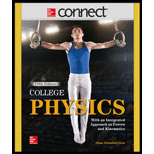
Concept explainers
The work done by gravity, work done by the normal force, the work done by the friction, and the magnitude of frictional force.
Answer to Problem 16P
The work done by the normal force is zero, the work done by gravity is
Explanation of Solution
The work done by the normal force on the skier is zero since the normal force is perpendicular to the direction of motion of the skier.
Write the expression for work done by the gravity.
Here,
From Figure 1 the vertical distance is given by
Use the above equation in equation (I).
The total work done on the skier is equal to sum of work done by the gravity, and work done by the friction.
Here,
The total work done by the skier is equal to the change in kinetic energy of the skier. The above equation is written as
Use equation (I) in the above equation and rearrange.
Since
Write the expression for work done by frictional force.
Here,
Rearrange the above equation to find
Conclusion:
Substitute
Substitute
Substitute
Therefore, the work done by the normal force is zero, the work done by gravity is
Want to see more full solutions like this?
Chapter 6 Solutions
COLLEGE PHYSICS-CONNECT ACCESS
 College PhysicsPhysicsISBN:9781305952300Author:Raymond A. Serway, Chris VuillePublisher:Cengage Learning
College PhysicsPhysicsISBN:9781305952300Author:Raymond A. Serway, Chris VuillePublisher:Cengage Learning University Physics (14th Edition)PhysicsISBN:9780133969290Author:Hugh D. Young, Roger A. FreedmanPublisher:PEARSON
University Physics (14th Edition)PhysicsISBN:9780133969290Author:Hugh D. Young, Roger A. FreedmanPublisher:PEARSON Introduction To Quantum MechanicsPhysicsISBN:9781107189638Author:Griffiths, David J., Schroeter, Darrell F.Publisher:Cambridge University Press
Introduction To Quantum MechanicsPhysicsISBN:9781107189638Author:Griffiths, David J., Schroeter, Darrell F.Publisher:Cambridge University Press Physics for Scientists and EngineersPhysicsISBN:9781337553278Author:Raymond A. Serway, John W. JewettPublisher:Cengage Learning
Physics for Scientists and EngineersPhysicsISBN:9781337553278Author:Raymond A. Serway, John W. JewettPublisher:Cengage Learning Lecture- Tutorials for Introductory AstronomyPhysicsISBN:9780321820464Author:Edward E. Prather, Tim P. Slater, Jeff P. Adams, Gina BrissendenPublisher:Addison-Wesley
Lecture- Tutorials for Introductory AstronomyPhysicsISBN:9780321820464Author:Edward E. Prather, Tim P. Slater, Jeff P. Adams, Gina BrissendenPublisher:Addison-Wesley College Physics: A Strategic Approach (4th Editio...PhysicsISBN:9780134609034Author:Randall D. Knight (Professor Emeritus), Brian Jones, Stuart FieldPublisher:PEARSON
College Physics: A Strategic Approach (4th Editio...PhysicsISBN:9780134609034Author:Randall D. Knight (Professor Emeritus), Brian Jones, Stuart FieldPublisher:PEARSON





